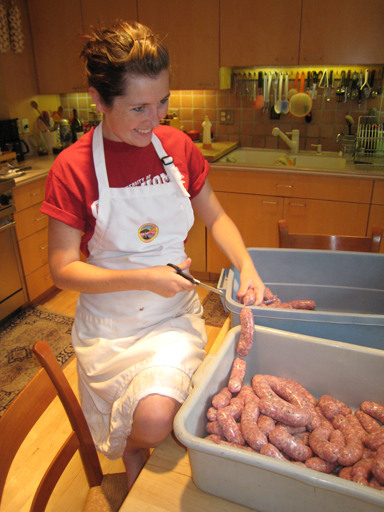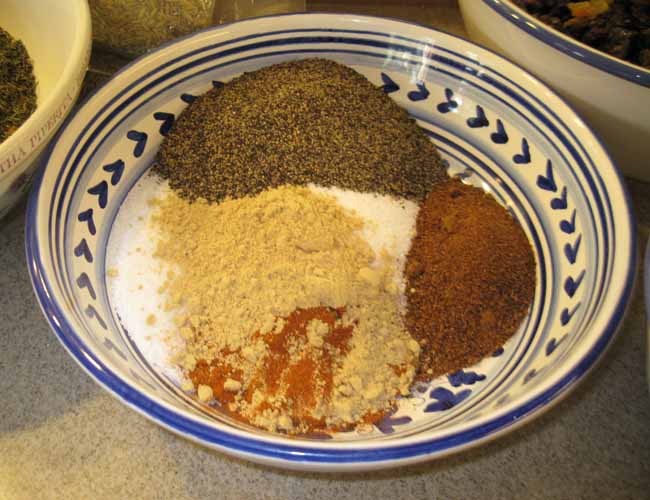Useful Tips on Making Sausages at Home — from SausageMania.com!
•
All SausageMania
Recipes,
except Spanish Chorizo and Portuguese linguica, use pork ground through a
3/16"
or 1/4" plate. This gives about the same consistency as standard supermarket
hamburger. (The linguica is made with very coarsely-chopped meat ground through
a 3/4" plate.) If you do not have your own grinder, some butchers will
sell unseasoned ground pork, usually 20-35% fat, ground with the same plate
as hamburger. Your butcher may be willing to coarse-grind pork for you, but
might require you to order a minimum of 10 pounds or so.
•
If you
have your own grinder,
buy pork shoulder roasts, sometimes called "Boston blade roasts," or
else use so-called country-style spare ribs, which are merely pork shoulder cut into strips: they are boneless and ready
to grind. The shoulder roasts have only about 10% bone by weight. The bone,
part of the scapula, is easy to remove with a boning knife.
•
Don't use a mix that is too lean!
Without adequate fat, your sausage will be dry when cooked, and will
tend to crumble when cut or sliced.
•
Use only the freshest spices. Don't
reach for that old jar of sage that you last used four years ago! It will
have lost most of its flavor.
•
For stuffing the sausages, you can use your grinder with
a sausage funnel attachment. (Don't forget to use the coarsest plate you
have, to allow the mix to come through easily!) Or else use one of the hand-cranked
piston or press type stuffers. The hand-cranked Chop-Rite
fruit and lard press, in continuous production for more than a century, works
well, as do the hand-cranked, piston stuffers made by F.
Dick (vertical), by Leonardi (horizontal and hard-to-find) or by other
manufacturers. A nice variety, including the inexpensive 3-lb cast iron "pump
handle" stuffer, can be found at Heinsohn's
Country Store in Texas. The indescructible Chop-Rite (formerly Enterprise)
stuffers are almost always available for auction on eBay
at excellent prices, or may be purchased new directly from Chop-Rite as well
as from its many retailers. On eBay, search under "fruit press,"
"lard press," "sausage stuffer," or "ChopRite."
•
Use only the finest natural casings — hog
for large sausages and sheep for small, breakfast-style links. Poor casings
will burst more easily, and will slow down your production significantly,
so it's worth spending a little bit extra for premium casings. One excellent
source of standard, pre-flushed or tubed casings is the Syracuse
Casing Company, whose salt-packed casings can be safely shipped anywhere
in the country by U.S. Mail and will last six months if refrigerated (NEVER
freeze casings!)
•
If you are using a grinder to stuff with, make sure the mix
is well-chilled. Otherwise, the grinder's feed screw will not "grab"
the mix and push it through into the casing, and you'll have to use a wood
stomper to force the mix into the grinder's throat. By chilled, we mean just
28-32° F. (Sausage mix will not freeze at 32° F., because of the
salt.)
•
If you are using a piston-type stuffer, the mix
temperature is not so critical. In fact, when the mix is fairly warm it will
go through the stuffer more easily and you'll get less "back flow"
around the "piston ring" on the plunger or pressure plate. When
using a piston-type stuffer for small bore casings, add about a pint of water
for every 20 lbs of mix. If you don't, the mix will be too "thick,"
and will require such high pressures to force it out through the narrow stuffing
tubethat the "O" ring in the piston will surely dislodge, causing
massive backflow of the mix into the cylinder, and making a mess.

Looks like fun, No? |
•
Filling small-bore sheep casings using any kind of home stuffer
will take up to five times longer than large-bore hog casings. So it's
a good idea to stuff your first-ever sausages into 29-42mm hog casings, or
you may get discouraged at the outset. Once you've mastered stuffing large-bore
casings, then give 18-22mm sheep casings a try.
•
If you plan to use tubed casings (a big time-saver), make sure
you have straight, not tapered, stuffing tubes, at least eight inches
long. You won't be able to get an entire tubed casing up onto a standard five-inch
tapered stuffing tube.
•
SausageMania Recipes call for coarse
salt, readily available under the Diamond or Morton labels. Ordinary
table salt will do as well, but never use iodized salt, as it will
impart a bad taste to your sausage!



